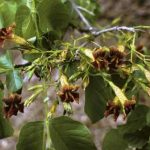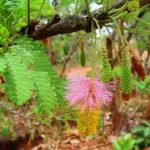TREE LIFE
March 1993
SUBSCRIPTIONS ARE NOW DUE FOR 1993/1994. Enclosed with this tree life is a combined statement and payment slip. The annual subscription remains unchanged at $20 but costs are forever rising and we would appreciate your payment by not later than 30th May, 1993.
MASHONALAND CALENDAR
Tuesday 2nd March : Botanic Garden Walk at 1445 hours for 1500 hours. Park at the Herbarium where we will meet Tom Muller.
Sunday 21st March : Mazvikadei Dam Area. We are privileged this month to be visiting two places. .
-Sanuganayi Creek which is a property of about 25 acres, is owned by Scripture Union. Apart from a few holiday cottages and a sports field the plot is undeveloped and covered with natural vegetation. We will meet at Sanganayi at 0900 hours and spend the morning there.
Saturday 27th March : Mark’s walk 1500 hours at the Blatherwick Ave. entrance to the Mukuvisi Woodland.
Tuesday 6th April: Botanic Garden Walk
MATABELELAND CALENDAR
Sunday 7th March : Visit to Amalinda Safari camp on the north-west boundary of the Matopos. This is a working visit which will involve drawing up a tree list for the operators as well as identifying and labelling trees. Members can make it a morning only or an all day visit. The camp is very attractively situated and its bar will be open at lunch time for members who wish to patronise it. Meet at Retreat for the usual 8.30 departure.
Monday 8th March : Urban trails. Meet at Hillside Dams at 1645 hours for 1700 hours.
Sunday 6th April : A.G.M. at Cyrene and this will be an all day visit.
Monday 7th : Urban Trails
Sunday 2nd May : A morning visit to Leopard Rock Kopje on the Khami Waterworks road.
NEW PUBLICATIONS ON INDIGENOUS SPECIES : We would like to acknowledge, with thanks, reviews of two handbooks :
A Guide to Growing Selected Indigenous Woody Plants by Malcolm Leppard and Stephen Duri, and Seed Germination of lndigenenous Trees in Botswana by Tabe Tietema which appeared in the February Tree Life, were extracts from Format Vol. 4 No.4 which is the Newsletter of the Research and Development Division Zimbabwe Forestry Commission.
BOTANIC GARDEN WALK : 2 FEBRUARY 1993
A smaller number of people than usual gathered at the Herbarium in threatening and some what damp weather for the second part of Tom’s look at the COMBRETACEAE and in particular the genus Combretum.
What defines a Combretum. The 4- (occasionally 5) winged fruit, the flower structure and, usually, the presence of scales (lepidote). Mostly, the leaves are opposite or in whorls and there are no stipules.
We concentrated mainly on the high or middle-veld species (apart from molle), which are probably the ones we see most often, and examined the characteristic features of these species.
C. adenogonium (formerly fragrans) has fresh green leaves which are usually in whorls of 3. ‘
C. apiculatum is commoner at lower altitudes and probably has the largest number of individuals of any Combretum species. The leaf is apiculate and the tip is slightly twisted. Tom mentioned how common this is in the Zambezi Valley.
We looked at several specimens of the very variable C. collinum, which has been divided into a number of subspecies. One of these was a dwarf subspecies occurring in Kalahari sand.
C. elaeagnoides is commonly an understorey tree in mopane woodland. The leaves have very noticeable silvery scales and have the appearance of an Elaeagnus suggests.
C. erythrophyllum has exceptionally small fruits and occurs mainly in riverine habitats. Tom explained that it was extremely sensitive to fire, unlike the others. The leaves may turn a beautiful autumnal red colour.
C. hereroense occurs in both hairy (softly velvety) and hairless forms, often right alongside one another. At the end of the walk, close ‘to 5th Street extension, we inspected a small tree covered in fruits, which are markedly rusty. C. hereroense commonly occurs in Kalahari sand.
C. imberbe is the Leadwood, so called because the wood is heavy. It has silvery-grey leaves and occurs mainly at medium and low altitudes. The lateral branchlets may become spiny.
C. zeyheri has particularly large fruits and is very widespread from low to high altitudes. It has a deep orange slash and often has leaves in threes. Of great interest were the numerous seedlings on the ground. The large green cotyledons were fused, apparently forming a single cotyledon peltate stalk.
Once again, our thanks to Tom for helping us to get to know the genus COMBRETUM.
MATABELELAND BRANCH : QUIET WATERS : ESIGODINI
With the heavy rains which had fallen in the course of the week, there was every likelihood of a very wet outing. In fact, the rain held off mid-afternoon. Unfortunately several of our regular members were unable to join us but our members were supplemented by eleven guests (almost equal to the number of members). It was wonderful to see water in the dams, lush green vegetation, fields of maize and groves of citrus as we drove to Falcon College. Gordon MacDonald was at the gate to meet us and lead the way to the interpretive centre, over dreadful speed bumps, which caused great concern to those with low-slung vehicles.
The Quiet Waters Nature Reserve is not new to us and there is a comprehensive card of trees and shrubs, copies of which were distributed. Our objective was to relate plant species to soil type.
After an introductory talk from Gordon on the geology and soils of the locality we set off. to look at two areas. The first in the immediate vicinity of the Study Centre which is situated on a schist ridge, has a substrate of iron-rich boulders and a characteristic red clay soil. This is skeletal, poorly developed and its bulk is chiefly made up of small angular rock fragments. The road from the study centre winds downhill and near the base, a line of cream-coloured boulders in the veld and sharp white flinty fragments on the road tell us that a quartz dyke has penetrated the schist belt. It is no more than a couple of metres wide, but its presence is enough to change the soil mineralisation and we notice the occurrence of plants we have not yet seen. At the base of the hill we cross the geological contact and step onto the granite and granite derived soils. The colours have changed dramatically. Underfoot dull red oxide turns to platinum blonde and stony clays become fine glassy sands. We have arrived at our second destination but we have walked less than one kilometre and more than an hour has passed since we first set off.
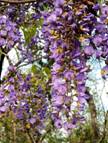
Bolusanthus speciosus, Photo: Bart Wursten. Source: Flora of Zimbabwe
In that time we have recorded 37 Species on the schists with Bolusanthus speciosus, Combretum apiculatum, Acacia nigrescens, Ormocarpum trichocarpum, Lannea discolor and Combretum hereroense being the most commonly occurring species. The distinctive grain of Albizia harveyi’s bark attracted our attention and we found a copse of four or five young trees growing on a more finely weathered and brighter red clay. Crossopteryx febrifuga provided a talking point, because at a casual glance, it was dismissed as Combretum molle, but its decussately paired leaves, its pink petioles and the remnant black umbels of last year’s flower and fruit crop ended its masquerade. In the middle levels, Euclea divinorum was seen everywhere and it seems to be the most successful shrub species in this environment. Perhaps the most interesting of all was Steganotaenia araliacea. We found it in fair abundance and all plants were less than knee-high. Is it the pioneer of a new succession after 1991’s devastating fire and 1992’s perishing drought?
It was a Terminalia sericea no more than 50 cm tall that told me things were changing. Then on the other side of the road I saw a Pterocrpus rotundifolius, more sapling, than seedling, and I thought we had crossed the contact between the schists and granite. But Gordon MacDonald corrected me. It was a quartz dyke, and there I could see it running across the slope of the land with studs of creamy white boulders on the hillside marking its intrusive presence. I followed it for about 50 metres and found Piliostigna thonningii and Strychnos spinosa neither of which we had seen further up the hill which we would not see again until we reached the granite.
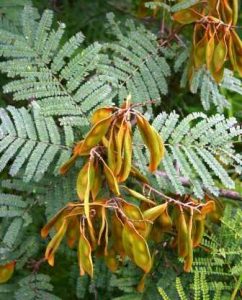
Peltophorum africanum. Photo: Bart Wursten. Source: Flora of Zimbabwe
After crossing the granite/schist contact we spent about another hour on the sandve1d but confined our investigation to the gently sloping plain below the grey rocky hills which rise to the summit of Usandisa. We recorded 28 species of which Terminalia sericea, Burkea africana, Peltophorum africanum, Clerodendrum glabrum, Pterocarpus angolensis and P. rotundifolius were the most common.
A sandy track cuts across this plain heading eastwards to “Gordon’s Gate”. To the north a sea of perennial grass (Hyparrhenia sp and Hyperthelia) is broken by an archipelago of woodland am shrub. Each island, dominated by a handsome peak, be Pterocarpus or a Ficus, which is surrounded by hillocks of lower vegetation, Clerodendrum, Terminalia and Ehretia and these give way sharply to the fields of waving grasses. This is a fire-controlled environment which has been exposed over several years to carefully managed burns. It is an interesting and attractive landscape.
South of the track the prospect is quite different. Minimal veld management has resulted in bush encroachment and its end product is a dismally monotonous thicket.
In 1991 the ‘Big Fire‘ swept in from across the southern boundary and consumed both this thicket and the wooded grassland to the north. In the thicket the scars are still evident in coppicing and in the dead and leafless limbs which rise out of this distorted regenerative growth. Years of careful nursing will of course heal things. In the wooded grassland, little evidence of the 1991 catastrophe remains. Recovery seems complete and certainly, no plastic surgery will be needed.
Eleven of the species recorded on the tree card for the day were found on both schists and granites and these included Albizia amara, Dichrostachys cinera, Maytenus senegalesis and heterophylla, Grewia flavescens and monticola, Azanza garckeana, Dombeya rotundifolia, Ozoroa insignis, Flueggea virosa, and Pseudolachnostylis maprouneifolia. It strikes me that these are the sort of plants that any new and enthusiastic tree lover could use as the initial core of an ever expanding inventory of trees and tree knowledge.
The purpose of the visit to Quiet Waters on this occasion was not to walk away from the hunt with a record bag and some rare trophies but to aim at a different set of targets. Soil and fire have done much to shape and distribute our wonderful plant communities. I hope that Sunday’s visit gave some insight into these aspects of plant ecology and I hope, too, that our many new visitors will have been sufficiently tantalized and tempted by the experience to come back again and again.
We offer our thanks to Gordon MacDonald and to Falcon College for making the day possible.
-Ian and Margaret Mccausland
MSASA FARM
With cars parked near a very large Azanza garckeana, in flower, some forty people slithered their way along the muddy banks of the dam towards the kopje containing bushman paintings.
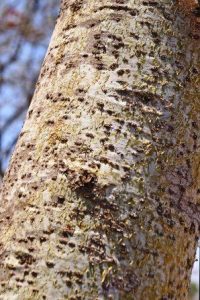
Commiphora mossambicensisis. Photo: Meg Coates Palgrave. Source: Flora of Zimbabwe
The riverine and lower slopes of the kopje were predominately Brachystegia woodland but with sizeable incursions of species such as Terminalia sericea and Ozoroa insignis on a flat grassy ledge red flowering Loranthus had parasitized almost every Commiphora mossambicensisin sight. With the recent rains many ferns had made an appearance, one of the more unusual ones rejoicing in the name of Actiniopteris. The leaf, no larger than a 20 cent piece had a set of tiny “fingers” radially spaced through a semi-circle – most unusual.
Interesting comparisons were ‘possible between the Maytenus family as three species occurred around the area, namely, M. heterophylla, M. senegalensis and M. undata. However, while wandering about in trees, the insignificant clouds of an hour earlier had developed into “something big” and within minutes the first heavy raindrops hit the ground. A remarkable increase in the pace of tree society members was noticed as everyone sought shelter.
Alas, the rain won and despite many forms of brollies and mac’s, lots of soaked humanity struggled and slithered towards the cave and rock paintings. Tony Weeks having reached the cave some while before the rain, found some interesting artefacts including pottery and a 1983 one-cent piece. Unfortunately, the main paintings had faded considerably. In the midst of the storm, the Hydes valiantly struggled to the top only to find the rain stopping some ten minutes later.
Wandering down the rear face of the kopje, Maureen found a most interesting ground orchid. Situated on a flat squelchy patch a strange double leaf grew close to the ground. A small white flower some 6 inches above the leaves was the only obvious sign of its presence. On closer examination, a number of these Habenaria stylites occurred in this damp spot.
With the sun making itself known again, it was good to dry off but the humidity from drying clothes was high. Thoughts of lunch soon drove out any weather-related discomfort.
The afternoon walk to an old fort produced the first Acacia sieberiana of the day, but the bush was too overgrown to approach the relics with ease. Instead, a well-worn footpath was followed along the stream. A brightly coloured blister beetle resplendent in its black and red warpaint caught our interest for a few minutes and for the second time, the heavens opened and sent us scrambling for cover.
Many thanks to the Coleman family for allowing us access to the kopje and despite being so wet it was a most enjoyable day.
NYARIIPIIIDA CATCHMENT : February 1993
The Scene : The water in the dam has risen approximately three metres and has a further six to go before it is full. Caterpillars, moths and butterflies are in their element, enjoying young green leaves, the wild flowers and the soft mud and sand near water. It is heartening to see the drought-stricken trees and shrubs budding again, also the new growth on young trees which have stagnated for years. The star amongst the introduced trees at Tinto is Croton sylvaticus, shapely and not far short of four metres in height, it was planted during 1989. A Tipuana tipu on the top lawn, planted for instant shade during our twilight years, has been taken over by Masked Weavers, today a male bird made the foundation for the sixteenth nest in the colony. With every ‘zik, zik’, leaf or leaflet is tugged or nipped off and litters the ground. Nearby on a clump of Heliotropium arborescens there are so many butterflies it is difficult to count them. Many indigenous trees are now in fruit, Pericopsis angolensis, Grewia monticola and Flacourtia indica are laden, why is the ripe black fruit of the latter so rarely seen? We must watch what happens to these little green apples, which they resemble rather than plums. ,
Civitries: These are all part of the scene especially now as they seem to be abandoned which means that the seeds which have germinated remain undisturbed, In the heap nearest the house there are 10cm high plantlets of Diospyros lycioides, Senna singueana and some resembling what could be Ficus egg (to be expected from all the seeds in the droppings). In time the mysterious seedlings may become recognisable. What amused us were two tomato plants at the edge of the seedbed mulched with chongololo rings.
Tree planting: The writer hopes that the weather, wherever you live has been suitable for planting trees and that you can watch them ‘take off’ . With “Gardening with Birds in Zimbabwe” in mind a large termite mound visible from the house has been planted with Berchemia discolour, Schotia brachypetala and Stereospermum kunthianum. Plants are massed by nature on termitaria so it will be interesting to see what happens.
Another species about to be planted was Bolusanthus speciosus, but after reading about its culture and care in Kristo Pienaar’s “Gardening with Indigenous Plants”, it might be wiser to let it grown on in its pot, whilst local advice is sought, with fifteen healthy leaves it looks ready for the open ground.
Wood samples and Bark: The standard textbook on the structure and properties of timber was written by H.E Desch, he recommended that samples should be the size of a matchbox, but he does not mention the orientation of the box when this shape is cut from the wood. The three planes of wood must be shown to best advantage; here is something different to do to while away a few moments: find a matchbox and go to a suitable piece of timber eg. tree, firewood, fence post, etc. and discover what Mr Desch saw no reason to tell students of forestry. The preparation of these samples would appear to be very hazardous, nevertheless, this simple exercise might lead to a collection of samples.
The samples in the round are a far cry from those used by the analyst of timber, the former are more practical, decorative and provide entertainment for ‘tree’ People, A glance along three shelves of pieces here reveals the different barks, a subject in itself and not so complicated as the tissues within. Here are a few eg guava, Durante, Jacaranda, Macadamia, Hakea, Grevillea, peach, rose, citrus, Cypress and a small piece of Fagus sylvatica (European beech) in—the round, elsewhere there is a goodly slice of cork oak from Powderham Castle near Exeter in Devon, England.
Some with very thick bark are Acacia amythethophylla, Faurea speciosa, Parinari curatellifolia; the thinnest Cordia goetzei. In Burkea africana the cylinder of wood has shrunk and its bark is a sleeve; Azanza garckeana has under-bark like horticultural bass. Two with pale-coloured thick cork are Maerua angolensis and Cussonia arborea. There are some much-coverted absentees… the paperbarks, it seems sacrilegious to cut them.
-Benedicta Graves
WILDLIFE CHIPINGE – HARONI – RUSITU
The Chipinge Branch of the Wild Life Society of Zimbabwe is seeking funds to protect and re-establish the two botanical reserves in the Haroni-Rusitu area.
Phase One: This will be the marking of legislated boundaries and fencing off each reserve.
Phase Two: To establish indigenous hardwood nurseries to be located at the Vumba school together with an interpretive centre. The school children would tend the seedlings and help to replant the devastated areas, receiving in turn financial support for their school.
The projects aim to make the local people and especially the children, the custodians of the botanical reserves.
PLEASE HELP US SAVE AND REGENERATE THESE BEAUTIFUL FORESTS…..
GEORGE HALL CHAIRMAN


